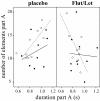Life-history and hormonal control of aggression in black redstarts: Blocking testosterone does not decrease territorial aggression, but changes the emphasis of vocal behaviours during simulated territorial intrusions
- PMID: 23433033
- PMCID: PMC3636094
- DOI: 10.1186/1742-9994-10-8
Life-history and hormonal control of aggression in black redstarts: Blocking testosterone does not decrease territorial aggression, but changes the emphasis of vocal behaviours during simulated territorial intrusions
Abstract
Introduction: Many studies in behavioural endocrinology attempt to link territorial aggression with testosterone, but the exact relationship between testosterone and territorial behaviour is still unclear and may depend on the ecology of a species. The degree to which testosterone facilitates territorial behaviour is particularly little understood in species that defend territories during breeding and outside the breeding season, when plasma levels of testosterone are low. Here we suggest that species that defend territories in contexts other than reproduction may have lost the direct regulation of territorial behaviour by androgens even during the breeding season. In such species, only those components of breeding territoriality that function simultaneously as sexually selected signals may be under control of sex steroids.
Results: We investigated black redstarts (Phoenicurus ochruros), a species that shows periods of territoriality within and outside of the breeding season. We treated territorial males with an anti-androgen and an aromatase inhibitor during the breeding season to block both the direct and indirect effects of testosterone. Three and ten days after the treatment, implanted males were challenged with a simulated territorial intrusion. The treatment did not reduce the overall territorial response, but it changed the emphasis of territoriality: experimental males invested more in behaviours addressed directly towards the intruder, whereas placebo-treated males put most effort into their vocal response, a component of territoriality that may be primarily directed towards their mating partner rather than the male opponent.
Conclusions: In combination with previous findings, these data suggest that overall territoriality may be decoupled from testosterone in male black redstarts. However, high levels of testosterone during breeding may facilitate-context dependent changes in song.
Figures







References
-
- Lincoln GA, Guinness F, Short RV. The way in which testosterone controls the social and sexual behavior of the red deer stag (Cervus elaphus) Horm Behav. 1972;3:375–396. doi: 10.1016/0018-506X(72)90027-X. - DOI
-
- Wingfield JC, Hegner RE, Dufty AM Jr, Ball GF. The "challenge hypothesis": theoretical implications for patterns of testosterone secretion, mating systems, and breeding strategies. Am Nat. 1990;136:829–846. doi: 10.1086/285134. - DOI
-
- Adkins-Regan E. Hormones and animal social behavior. Princeton: Princeton University Press; 2005.
LinkOut - more resources
Full Text Sources
Other Literature Sources

